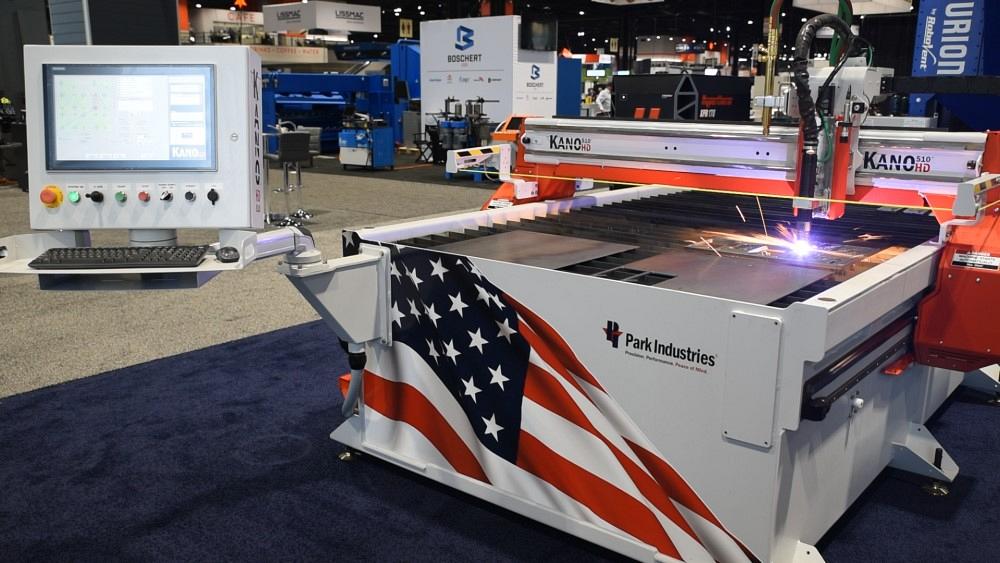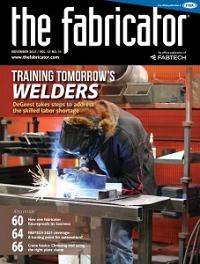Editor-in-Chief
- FMA
- The Fabricator
- FABTECH
- Canadian Metalworking
Categories
- Additive Manufacturing
- Aluminum Welding
- Arc Welding
- Assembly and Joining
- Automation and Robotics
- Bending and Forming
- Consumables
- Cutting and Weld Prep
- Electric Vehicles
- En Español
- Finishing
- Hydroforming
- Laser Cutting
- Laser Welding
- Machining
- Manufacturing Software
- Materials Handling
- Metals/Materials
- Oxyfuel Cutting
- Plasma Cutting
- Power Tools
- Punching and Other Holemaking
- Roll Forming
- Safety
- Sawing
- Shearing
- Shop Management
- Testing and Measuring
- Tube and Pipe Fabrication
- Tube and Pipe Production
- Waterjet Cutting
Industry Directory
Webcasts
Podcasts
FAB 40
Advertise
Subscribe
Account Login
Search
Machine provides a solid foundation for plasma cutting
Park Industries wraps its plasma cutting expertise in a smaller package
- By Dan Davis
- November 11, 2021
- Article
- Plasma Cutting

Park Industries demonstrates the cutting capabilities of its KANO HD 510 plasma cutting system at FABTECH.
A new 5- by 10-ft. plasma cutting table doesn’t sound like an earth-shattering product introduction, but when an almost 70-year-old machine tool manufacturer introduces such a table at FABTECH, it catches people’s attention.
Park Industries, St. Cloud, Minn., has been around since 1953 and spent a majority of that time making stone cutting machines. In a bid to diversify its business, about six years ago it started making large-scale plasma cutting systems, some reaching as large as 10 by 24 ft., for the metal fabricating market.
The motivation to introduce the KANO HD 510 came with a realization that a majority of the metal fabricating shops in the U.S. work with 5- by 10-ft. sheets and plate. Discussions with dealers that sold laser cutting machines revealed that most of the machines sold actually have tables of the same size. Even larger operations, such as shipbuilding companies, might require the smaller plasma table for a repair shop or smaller jobs, according to Al Holst, Park Industries’ business development leader for metals.
“This table size will suit more people, and its potential popularity is evidenced by the interest online and the active interest and request for quotes that we saw at FABTECH,” Holst said.
He added that the heavy-duty steel construction of the gantry beam and machine frame also stands out to interested parties. The use of structural steel tubing and plate with additional steel reinforcements creates a solid foundation that doesn’t change even when plasma—or even oxyfuel—torches are operating over an entire shift. That solid steel construction combined with linear ways and precision gear racks allows the plasma cutting table to attain bidirectional accuracy of at least +/- 0.004 in., which is laser-verified before leaving the factory, Holst said. It turns out that a company that has a long history of making “saw jets” for cutting through stone knows a thing or two about engineering a machine tool that can maintain accuracy while cutting.
“We verify that it will perform correctly in operation as it goes through final inspection. We don’t want to find a machine in the field that isn’t working correctly,” he said.
These devices are designed to deliver positioning speeds of 1,500 IPM, which Holst describes as “plenty good” for the size of the table and for the market. Acceleration of the torch, however, is where the KANO HD 510 differentiates itself from other 5- by 10-ft. tables on the market, according to the company.
“We’ve designed this system to produce 160 milli-Gs of acceleration. That’s not what you’d find on the fast and expensive lasers, but for a plasma cutting machine, that is pretty quick,” Holst said. “This thing is going to go from zero to 1,500 IPM in under half a second.”
Holst added that the plasma cutting system also has a couple of features that aren’t commonly found on other tables. One is a cable-activated emergency stop, which is actually on all machines Park Industries manufactures. The e-stops are located on the front and rear of the gantry beam. If the cable is pulled, the machine is electronically stopped to avoid potential injury to the person near the cutting action. The machine also has tucked rails along its length that cover the linear ways and gear rack, which allows that sensitive equipment to avoid possible damage when large sheets of metal are loaded and unloaded onto the machine over the edges.
The plasma cutting machine is available with Hypertherm Powermax air plasma, MAXPRO200 oxygen plasma, or an XPR high-definition plasma system. An oxyfuel torch is also available. Included is the Hypertherm EDGE Connect CNC.
“If someone is not in a position to pay for or budget for the costs of a high-definition plasma system, they can start out with an air plasma,” Holst said. “When they are ready for high-definition cutting, the machine is still appropriate for the work. There are many small machines out there where you would just have to start over making that kind of a move because they aren’t suitable for high-definition at all.”
Even though Park Industries hasn’t been serving the metal fabricating community as long as it has stone fabricators, Holst said the company is earning sales of its plasma cutting machines based on the same engineering success and customer support that have helped to grow its stone-related business. Small improvements in what many might consider a ubiquitous piece of equipment are noticed by those that demand a lot of their cutting machines. Holst said that’s why he thinks fabricators will like the KANO HD 510.
About the Author

Dan Davis
2135 Point Blvd.
Elgin, IL 60123
815-227-8281
Dan Davis is editor-in-chief of The Fabricator, the industry's most widely circulated metal fabricating magazine, and its sister publications, The Tube & Pipe Journal and The Welder. He has been with the publications since April 2002.
subscribe now

The Fabricator is North America's leading magazine for the metal forming and fabricating industry. The magazine delivers the news, technical articles, and case histories that enable fabricators to do their jobs more efficiently. The Fabricator has served the industry since 1970.
start your free subscription- Stay connected from anywhere

Easily access valuable industry resources now with full access to the digital edition of The Fabricator.

Easily access valuable industry resources now with full access to the digital edition of The Welder.

Easily access valuable industry resources now with full access to the digital edition of The Tube and Pipe Journal.
- Podcasting
- Podcast:
- The Fabricator Podcast
- Published:
- 04/16/2024
- Running Time:
- 63:29
In this episode of The Fabricator Podcast, Caleb Chamberlain, co-founder and CEO of OSH Cut, discusses his company’s...
- Trending Articles
How to set a press brake backgauge manually

Capturing, recording equipment inspection data for FMEA

Tips for creating sheet metal tubes with perforations

Are two heads better than one in fiber laser cutting?

Hypertherm Associates implements Rapyuta Robotics AMRs in warehouse

- Industry Events
16th Annual Safety Conference
- April 30 - May 1, 2024
- Elgin,
Pipe and Tube Conference
- May 21 - 22, 2024
- Omaha, NE
World-Class Roll Forming Workshop
- June 5 - 6, 2024
- Louisville, KY
Advanced Laser Application Workshop
- June 25 - 27, 2024
- Novi, MI


























